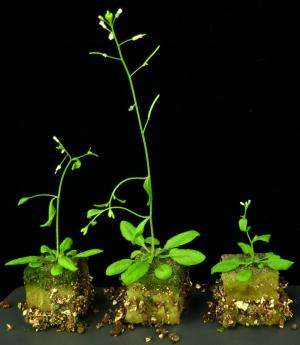Figure 1: Thale cress plants with different myosin XI motor domains. Compared with the wild-type plant (left), plants with fast myosin XI are larger (middle) and plants with slow myosin XI are smaller (right). Credit: Elsevier
The contents of plant cells undergo continuous mixing by a process known as cytoplasmic streaming. Yet although this process was discovered more than 200 years ago, its exact purpose has remained unclear. Motoki Tominaga from the Live Cell Molecular Imaging Research Team at the RIKEN Center for Advanced Photonics and colleagues have now shown that the speed of cytoplasmic streaming is a key factor in determining plant size.
Cytoplasmic streaming is a 'stirring' mechanism thought to ensure that nutrients and other molecules are evenly distributed throughout the cell. The movement is generated by a protein called myosin XI, which has a motor domain that allows it to slide along actin filaments in the cell's skeleton.
"It has been shown that the genetic knockout of myosin XI proteins leads to growth defects in plants," explains Tominaga. "While this raises the possibility that plant cell size is related to cytoplasmic streaming, it is difficult to elucidate the link using conventional methods."
To investigate, Tominaga and his colleagues had to devise a new approach. Rather than knocking out myosin XI, they changed the speed of its movement in thale cress, Arabidopsis thaliana, by swapping the motor domain for either a faster version from an alga called Chara corallina or a slower version from humans.
Introducing the faster motor domain increased the speed of cytoplasmic streaming and led to larger than normal plants with bigger leaves and greater height and weight. Correspondingly, the slower human motor domain resulted in the opposite—slower cytoplasmic streaming and smaller than normal plants (Fig. 1). The differences in plant size were found to be due to differences in the sizes of cells rather than their number. The researchers' results indicate that faster cytoplasmic streaming allows plant cells to grow larger, making it a key factor in plant size.
Tominaga says these findings not only demonstrate the function of cytoplasmic streaming for the first time, but could also provide a new way of controlling plant size so that plants may overcome the constraints of their environments.
"Many attempts have been made to enhance plant size for crops, but if done artificially, physical stimuli such as wind and rain can cause the taller plants to fall," says Tominaga. "Our system may solve this problem. By expressing slower myosin XI at the shoot and faster myosin XI in other tissues like the leaf and root, we could develop plants that have high resistance to wind and rain but increased biomass."
More information: Tominaga, M., Kimura, A., Yokota, E., Haraguchi, T., Shimmen, T., Yamamoto, K., Nakano, A. & Ito, K. "Cytoplasmic streaming velocity as a plant size determinant." Developmental Cell 27, 345–352 (2013). dx.doi.org/10.1016/j.devcel.2013.10.005
Journal information: Developmental Cell
Provided by RIKEN






















